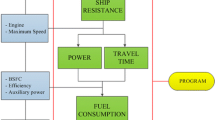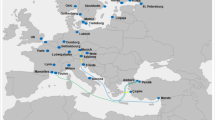Abstract
The influence of various parameters, such as ship initial speed (full ahead and lower engine loads), loading condition, heading angle and weather conditions on ship fuel consumption and CO2 emission is presented. A reliable methodology for estimating the attainable ship speed, fuel consumption and CO2 emission in different sea states is described. The speed loss is calculated by taking into account the engine and propeller performance in actual seas as well as the mass inertia of the ship. The attainable ship speed is obtained as time series. Correlation of speed loss with sea states allows predictions of propulsive performance in actual seas. If the computation is used for weather routing purposes, values for various ship initial speed, loading conditions and heading angles for each realistic sea‐state must be provided. The voluntary speed loss is taken into account. The influence of the ship speed loss on various parameters such as fuel consumption and CO2 emissions is presented. To illustrate the presented concept, the ship speed and CO2 emissions in various routes of the Atlantic Ocean are calculated using representative environmental design data for the track of the routes where the ship will sail.

























Similar content being viewed by others
References
IMO (2009) Prevention of air pollution from ships—second IMO GHG study. MEPC 59/INF.10, International Maritime Organization
IMO (2012) Prevention of air pollution from ships, IMO GHG study. MEPC 63 and 64, International Maritime Organization
IMO (2008) Prevention of air pollution from ships—opportunities for reducing greenhouse gas emissions from ships. MEPC 58/INF.21, International Maritime Organization
Chen H, Cardone V, Lacey P (1998) Use of operation support information technology to increase ship safety and efficiency. SNAME Trans 106:105–127
Delitala AMS, Gallino S, Villa L, Lagouvardos K, Drago A (2010) Weather routing in long-distance Mediterranean routes. Theoret Appl Climatol 102(1–2):125–137
Gershanik VI (2011) Weather routing optimisation—challenges and rewards. J Marine Eng Technol 10(3):29–40
Guedes Soares C (1990) Effect of heavy weather maneuvering on the wave induced vertical bending moments in ship structures. J Ship Res 34(1):60–68
Intertanko (2011) Virtual arrival—optimising voyage management and reducing vessel emissions—an emissions management framework. 2nd edn. Oil Companies International Marine Forum (OCIMF), London, UK
Dallinga R, Flikkema M, Grin R (2008) Challenging wind and waves—their impact on fuel consumption. MARIN Rep 94:1–3
Kwon YJ (2008) Speed loss due to added resistance in wind and waves. The Naval Architect, RINA (U.K.), pp 14–16
Minoura M, Naito S (2008) Statistical Estimation of ship speed loss by monitoring data. In: Proceedings of the 6th Osaka colloquium on seakeeping and stability of ships, Osaka, Japan, pp 37–42
Prpić-Oršić J, Faltinsen OM (2012) Estimation of ship speed loss and associated CO2 emissions in a seaway. Ocean Eng 44(1):1–10
Wang SA, Meng Q (2012) Liner ship route schedule design with sea contingency time and port time uncertainty. Transp Res Part B Methodol 46(5):615–633
Tsou MC, Kao SL, Su CM (2010) Decision support from genetic algorithms for ship collision avoidance route planning and alerts. J Navig 63(1):167–182
Kim HJ, Chang YT, Kim KT, Kim HJ (2012) An epsilon-optimal algorithm considering greenhouse gas emissions for the management of a ship’s bunker fuel. Transp Res Part D Transp Environ 17(2):97–103
Qi XT, Song DP (2012) Minimizing fuel emissions by optimizing vessel schedules in liner shipping with uncertain port times. Transp Res Part E Logist Transp Rev 48(4):863–880
Rusu L, Guedes Soares C (2014) Forecasting container-ship responses in the Azores Archipelago. In: Guedes Soares C, Lopez Pena F (eds) Developments in maritime transportation and exploitation of sea resources. Francis & Taylor Group London, UK, pp 987–994
Vlachos DS (2004) Optimal ship routing based on wind and wave forecasts. Appl Numer Anal Comput Math 1(2):547–551
Panigrahi JK, Padhy CP, Sen D, Swain J, Larsen O (2012) Optimal ship tracking on a navigation route between two ports: a hydrodynamics approach. J Mar Sci Technol 17(1):59–67
Tsujimoto M, Hinnenthal J (2008) Optimum navigation for minimizing ship fuel consumption—investigation of route, speed and seakeeping performance. In: Proceedings of the 6th Osaka Colloquium on Seakeeping and Stability of Ships, Osaka, Japan, pp 43–50
Shao W, Zhou PL, Thong SK (2012) Development of a novel forward dynamic programming method for weather routing. J Mar Sci Technol 17(2):239–251
Guedes Soares C, Fonseca N, Ramos J (1998) Prediction of voyage duration with weather constraints. In: Proceedings International Conference on Motions and Manoeuvrability, Royal Institute of Naval Architects, London
Prpić-Oršić J, Faltinsen OM (2009) Speed loss calculation in a Seaway. The 13th Congress IMAM 2009, Istanbul, Turkey, pp 393–400
Pacheco MB, Guedes Soares C (2007) Ship weather routing based on seakeeping performance. Advancements in Marine Structures. In: Guedes Soares C, Das PK (ed). Taylor & Francis Group, London, pp 71–78
ITTC (1978) Report of the Seakeeping Committee. In: Proceedings of the 15th International Towing Tank Conference, vol 1. The Hague, Netherlands
Faltinsen OM, Minsaas KJ, Liapis N, Skjordal SO (1980) Prediction of resistance and propulsion of a ship in a seaway. In: Proc. 13th Symposium on Naval Hydrodynamics, pp 505–529
Holtrop JA, Mennen GGJ (1982) An approximate power prediction method. Int Shipbuild Progr 29:166–170
Holtrop JA (1984) Statistical reanalysis of resistance and propulsion data. Int Shipbuild Progr 31:272–276
Matulja D, Sportelli M, Guedes Soares C, Prpić-Oršić J (2011) Estimation of added resistance of a ship in regular waves. Brodogradnja 62(3):259–272
Medica V, Mrakovčić T (2002) Compressor map representation in numerical simulations of turbocharged diesel engine steady and transient operation. In: Proceedings of the Symposium Motors and Vehicles, Zagreb, pp 1–10
Oosterveld MWC, van Oossanen P (1975) Further computer-analyzed data of Wageningen B-screw series. Int Shipbuild Progress 22(251):3–14
Smogeli ON (2006) Control of marine propellers—from normal to extreme conditions. PhD-thesis 2006:187, Faculty of Engineering Science & Technology, Trondheim
Blendermann W (1996) Floating docks: prediction of wind loads in extreme winds. Schiff und Hafen 48:4
Harris RI (1971) The nature of the wind, the modern design of wind sensitive structures. Construction Industry Research and Information Association, London
Faltinsen OM, Svensen T (1990) Incorporation of seakeeping theories in CAD. CFD and CAD in Ship Design. Elsevier Science Publishers B. V., Amsterdam
Prpić-Oršić J, Parunov J, Šikić I (2014) Operation of ULCS—real life. Int J Naval Archit Ocean Eng 6(6):1014–1023
Prpić-Oršić J, Faltinsen OM, Mrakovčić T (2013) Influence of ship behaviour in a seaway on CO2 emissions. In: Proceedings of the 32nd International Conference on Ocean, Offshore and Arctic Engineering (DVD), OMAE 2103, Nantes, France, pp 1–8
Prpić-Oršić J, Vettor R, Faltinsen OM, Guedes Soares C (2014a) Influence of ship routes on fuel consumption and CO2 emission. The 2nd Congress Maritime Technology and Engineering—MARTECH 2014, Lisabon, Portugal, pp 857–864
EMEP/CORINAIR (1999) EMEP Co-operative programme for monitoring and evaluation of the long range transmission of air pollutants in Europe, the core inventory of air emissions in Europe, September 1999. Atmospheric Emission Inventory Guidebook, Second Edition
IACS (2000) Standard Wave Data. International Association of Classification Societies, Rec. No. 034
Vettor R, Guedes Soares C (2015) Detection and analysis of the main routes of voluntary observing ships in the North Atlantic. J Navig 68(2015):397
Guedes Soares C (2008) Hindcast of dynamic processes of the ocean and coastal areas of Europe. Coast Eng 55(11):825–826
Pilar P, Guedes Soares C, Carretero JC (2008) 44-year wave hindcast for the North East Atlantic European coast. Coast Eng 55:861–871
Dolinskaya IS, Kotinis M, Parsons MG, Smith RL (2009) Optimal short-range routing of vessels in a seaway. J Ship Res 53(3):121–129
Guedes Soares C, Moan T (1991) Model uncertainty in the long term distribution of wave induced bending moments for fatigue design of ship structures. Marine Struct 4:295–315
Acknowledgments
This work was performed within the project SHOPERA—Energy Efficient Safe SHip OPERAtion, which was partially funded by the EU under contract 605221. This work was also supported by the Research Council of Norway through the Centres of Excellence funding scheme AMOS, project number 223254, Croatian science foundation (project Greener Approach to Ship Design and Optimal Route Planning) and University of Rijeka (contract no. 13.09.1.1.05). The second author was supported by the Portuguese Foundation for Science and Technology (FCT—Fundação para a Ciência e Tecnologia, Portugal) under the contract no. SFRH/BD/89476/2012.
Author information
Authors and Affiliations
Corresponding author
About this article
Cite this article
Prpić-Oršić, J., Vettor, R., Faltinsen, O.M. et al. The influence of route choice and operating conditions on fuel consumption and CO2 emission of ships. J Mar Sci Technol 21, 434–457 (2016). https://doi.org/10.1007/s00773-015-0367-5
Received:
Accepted:
Published:
Issue Date:
DOI: https://doi.org/10.1007/s00773-015-0367-5




